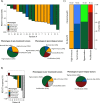Molecular stratification of metastatic melanoma using gene expression profiling: Prediction of survival outcome and benefit from molecular targeted therapy
- PMID: 25909218
- PMCID: PMC4494939
- DOI: 10.18632/oncotarget.3655
Molecular stratification of metastatic melanoma using gene expression profiling: Prediction of survival outcome and benefit from molecular targeted therapy
Abstract
Melanoma is currently divided on a genetic level according to mutational status. However, this classification does not optimally predict prognosis. In prior studies, we have defined gene expression phenotypes (high-immune, pigmentation, proliferative and normal-like), which are predictive of survival outcome as well as informative of biology. Herein, we employed a population-based metastatic melanoma cohort and external cohorts to determine the prognostic and predictive significance of the gene expression phenotypes. We performed expression profiling on 214 cutaneous melanoma tumors and found an increased risk of developing distant metastases in the pigmentation (HR, 1.9; 95% CI, 1.05-3.28; P=0.03) and proliferative (HR, 2.8; 95% CI, 1.43-5.57; P=0.003) groups as compared to the high-immune response group. Further genetic characterization of melanomas using targeted deep-sequencing revealed similar mutational patterns across these phenotypes. We also used publicly available expression profiling data from melanoma patients treated with targeted or vaccine therapy in order to determine if our signatures predicted therapeutic response. In patients receiving targeted therapy, melanomas resistant to targeted therapy were enriched in the MITF-low proliferative subtype as compared to pre-treatment biopsies (P=0.02). In summary, the melanoma gene expression phenotypes are highly predictive of survival outcome and can further help to discriminate patients responding to targeted therapy.
Keywords: BRAF; BRAF inhibitor; gene expression; melanoma; mutation.
Conflict of interest statement
There is no conflict of interest that we should disclose.
Figures




Similar articles
-
Prognostic and clinicopathologic associations of oncogenic BRAF in metastatic melanoma.J Clin Oncol. 2011 Apr 1;29(10):1239-46. doi: 10.1200/JCO.2010.32.4327. Epub 2011 Feb 22. J Clin Oncol. 2011. PMID: 21343559
-
Association Between NRAS and BRAF Mutational Status and Melanoma-Specific Survival Among Patients With Higher-Risk Primary Melanoma.JAMA Oncol. 2015 Jun;1(3):359-68. doi: 10.1001/jamaoncol.2015.0493. JAMA Oncol. 2015. PMID: 26146664 Free PMC article.
-
A Combined Proteomic and Transcriptomic Signature Is Predictive of Response to Anti-PD-1 Treatment: A Retrospective Study in Metastatic Melanoma Patients.Int J Mol Sci. 2024 Aug 28;25(17):9345. doi: 10.3390/ijms25179345. Int J Mol Sci. 2024. PMID: 39273294 Free PMC article.
-
Braf-Mutant Melanomas: Biology and Therapy.Curr Oncol. 2024 Dec 3;31(12):7711-7737. doi: 10.3390/curroncol31120568. Curr Oncol. 2024. PMID: 39727691 Free PMC article. Review.
-
Molecular testing for BRAF mutations to inform melanoma treatment decisions: a move toward precision medicine.Mod Pathol. 2018 Jan;31(1):24-38. doi: 10.1038/modpathol.2017.104. Epub 2017 Nov 17. Mod Pathol. 2018. PMID: 29148538 Free PMC article. Review.
Cited by
-
microRNA-7-5p inhibits melanoma cell proliferation and metastasis by suppressing RelA/NF-κB.Oncotarget. 2016 May 31;7(22):31663-80. doi: 10.18632/oncotarget.9421. Oncotarget. 2016. PMID: 27203220 Free PMC article.
-
Construction and validation of a prognostic risk model of angiogenesis factors in skin cutaneous melanoma.Aging (Albany NY). 2022 Feb 14;14(3):1529-1548. doi: 10.18632/aging.203895. Epub 2022 Feb 14. Aging (Albany NY). 2022. PMID: 35157610 Free PMC article.
-
RNA-seq analysis identifies different transcriptomic types and developmental trajectories of primary melanomas.Oncogene. 2018 Nov;37(47):6136-6151. doi: 10.1038/s41388-018-0385-y. Epub 2018 Jul 11. Oncogene. 2018. PMID: 29995873
-
Identifying baseline immune-related biomarkers to predict clinical outcome of immunotherapy.J Immunother Cancer. 2017 May 16;5:44. doi: 10.1186/s40425-017-0243-4. eCollection 2017. J Immunother Cancer. 2017. PMID: 28515944 Free PMC article. Review.
-
Molecular patterns of resistance to immune checkpoint blockade in melanoma.Nat Commun. 2024 Apr 9;15(1):3075. doi: 10.1038/s41467-024-47425-y. Nat Commun. 2024. PMID: 38594286 Free PMC article.
References
-
- Balch CM, Gershenwald JE, Soong SJ, Thompson JF, Atkins MB, Byrd DR, Buzaid AC, Cochran AJ, Coit DG, Ding S, Eggermont AM, Flaherty KT, Gimotty PA, Kirkwood JM, McMasters KM, Mihm MC, Jr, et al. Final version of 2009 AJCC melanoma staging and classification. J Clin Oncol. 2009;27:6199–6206. - PMC - PubMed
-
- Thompson JF, Scolyer RA, Kefford RF. Cutaneous melanoma. Lancet. 2005;365:687–701. - PubMed
-
- Winnepenninckx V, Lazar V, Michiels S, Dessen P, Stas M, Alonso SR, Avril MF, Ortiz Romero PL, Robert T, Balacescu O, Eggermont AM, Lenoir G, Sarasin A, Tursz T, van den Oord JJ, Spatz A. Gene expression profiling of primary cutaneous melanoma and clinical outcome. J Natl Cancer Inst. 2006;98:472–482. - PubMed
-
- Mann GJ, Pupo GM, Campain AE, Carter CD, Schramm SJ, Pianova S, Gerega SK, De Silva C, Lai K, Wilmott JS, Synnott M, Hersey P, Kefford RF, Thompson JF, Yang YH, Scolyer RA. BRAF mutation, NRAS mutation, and the absence of an immune-related expressed gene profile predict poor outcome in patients with stage III melanoma. J Invest Dermatol. 2013;133:509–517. - PubMed
Publication types
MeSH terms
Substances
Grants and funding
LinkOut - more resources
Full Text Sources
Other Literature Sources
Medical
Molecular Biology Databases
Research Materials

